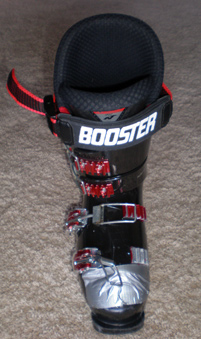skiing: Elite Feet perfecting boots
The Nordica Dobermans I got 5 years ago at Elite Feet still fit well. The foot crushing soon relaxed into a snug fit. But two problems: I know Cosmo's Footwerks makes beefy power straps but I wanted to stay with Elite Feet who have adjusted and repaired the boots a few times over the years, always for free. I went in mid-week while Christian was around (Elite Feet is busy with a second shop at Northstar) and he replaced Nordica's joke straps with BOOSTER straps. These have a huge vibration-damping pad in front and a solid metal cam closure that locks in tight.
I know Cosmo's Footwerks makes beefy power straps but I wanted to stay with Elite Feet who have adjusted and repaired the boots a few times over the years, always for free. I went in mid-week while Christian was around (Elite Feet is busy with a second shop at Northstar) and he replaced Nordica's joke straps with BOOSTER straps. These have a huge vibration-damping pad in front and a solid metal cam closure that locks in tight.
As for the water intrusion, I used the awesome power of duct tape and it's made some improvement. Nordica inexplicably cut a notch into the shell near the first buckle.
Meanwhile a Shred Betty had some problems angulating and engaging her inside ski's outside edge in her Nordica boots. Legendary instructor Tim Reeve recommended Start Haus to her boots and possible canting. But instead of working with the boots she brought, the boot fitter said they were too loose and tried to put her in Dobermans. Rule 1: if someone tries to put you in a tighter boot, they're showing off their boot-fitting prowess above listening to your needs. Instead, Christian at Elite Feet suggested removing her liners, allowing them to swell up and reverse some of the "packing out" that compresses the liner over the years. He tested her for canting using Elite Feet's complex mechanical rig (much better than a plumb bob from the knee, and shaved her boots down, inserting the special red shims in the photo and planing the boots so they engage with bindings.
I was hoping a gross misalignment would explain my blown turns to the right with my left ski railing instead of engaging a turn, but no such luck; Christian tested me on the rig and I'm true.
- the sloppy Italians used a velcro™ knockoff for the power strap at the topthat simply doesn't velk — the straps break loose while skiing and slide apart when I carry the boots
- water gets into the shell and after a few hours of skiing I can feel dampness in the liner
 I know Cosmo's Footwerks makes beefy power straps but I wanted to stay with Elite Feet who have adjusted and repaired the boots a few times over the years, always for free. I went in mid-week while Christian was around (Elite Feet is busy with a second shop at Northstar) and he replaced Nordica's joke straps with BOOSTER straps. These have a huge vibration-damping pad in front and a solid metal cam closure that locks in tight.
I know Cosmo's Footwerks makes beefy power straps but I wanted to stay with Elite Feet who have adjusted and repaired the boots a few times over the years, always for free. I went in mid-week while Christian was around (Elite Feet is busy with a second shop at Northstar) and he replaced Nordica's joke straps with BOOSTER straps. These have a huge vibration-damping pad in front and a solid metal cam closure that locks in tight.As for the water intrusion, I used the awesome power of duct tape and it's made some improvement. Nordica inexplicably cut a notch into the shell near the first buckle.
Meanwhile a Shred Betty had some problems angulating and engaging her inside ski's outside edge in her Nordica boots. Legendary instructor Tim Reeve recommended Start Haus to her boots and possible canting. But instead of working with the boots she brought, the boot fitter said they were too loose and tried to put her in Dobermans. Rule 1: if someone tries to put you in a tighter boot, they're showing off their boot-fitting prowess above listening to your needs. Instead, Christian at Elite Feet suggested removing her liners, allowing them to swell up and reverse some of the "packing out" that compresses the liner over the years. He tested her for canting using Elite Feet's complex mechanical rig (much better than a plumb bob from the knee, and shaved her boots down, inserting the special red shims in the photo and planing the boots so they engage with bindings.

I was hoping a gross misalignment would explain my blown turns to the right with my left ski railing instead of engaging a turn, but no such luck; Christian tested me on the rig and I'm true.

